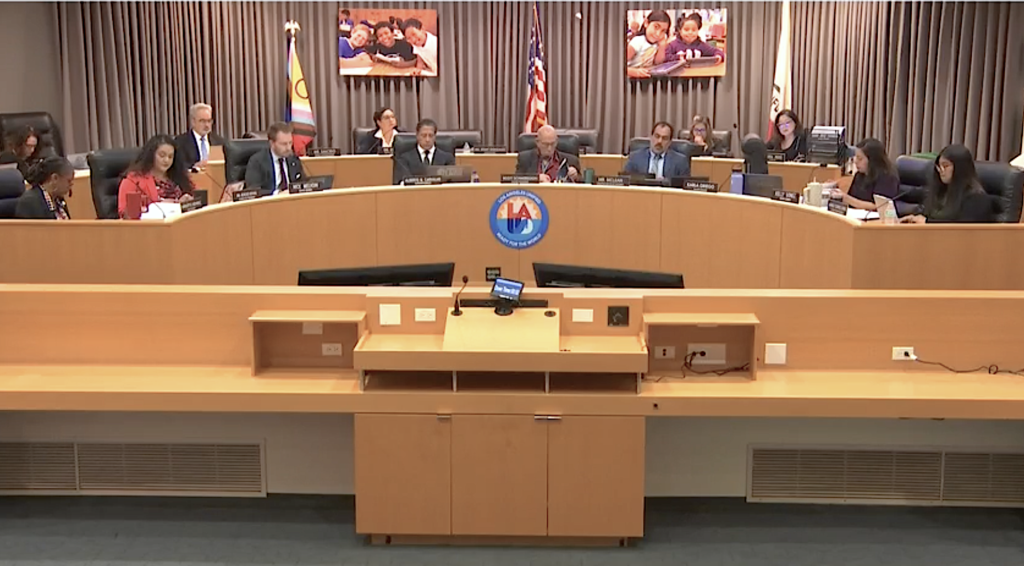
The Los Angeles Unified school board did not discuss the bonds for settling sexual abuse claims before members authorized them on June 3.
Credit: Livestream recordings of LAUSD board meetings
The article was updated on June 18 to include LAUSD’s previously undisclosed information revising total costs of the bonds it authorized to settle sexual abuse claims against it.
Top Takeaways
- School trustees authorize bonds without comment or public explanation.
- The total cost of $500 million in bonds could reach $765 million.
- Other districts also face massive costs in response to a 2019 state law.
The Los Angeles Unified School District board has quietly authorized issuing a half-billion dollars in bonds to settle decades-old sexual abuse cases involving former students.
And that will likely not be enough to settle all the claims the nation’s second-largest school district is facing under 2019 legislation that allows victims of abuse by school employees to seek damages for incidents dating back decades.
Since Jan. 1, 2020, LAUSD has received approximately 370 child abuse claims under Assembly Bill 218, of which 81 cases have been settled or dismissed, according to data that LAUSD released this week. The district stated it is currently defending against more than 275 claims; approximately 76 allege abuses dating back to the 1940s through 1970s, while 45 to 50 claims allege abuses in the 1980s.
Board members approved the expenditure on June 3 without comment or a public presentation, agreeing to borrow up to $500 million through judgment obligation bonds. Unlike bonds for school construction, they did not require voter approval. The claims are not covered by insurance carriers.
The scant information in the meeting agenda estimated the total cost of the bonds, including principal and interest, at $899 million. It assumed a now outdated 6.10% interest rate, documents show (see Page 3).
On Monday, the district lowered its estimate. It said it would initially issue $303 million in 15-year bonds, instead of 20-year bonds, at the current interest rate of 5.6%. At that rate, the total cost of $500 million in bonds would be $765 million.
“The board has been talking about judgment obligation bonds for, I would say, about a year and a half,” board member Tanya Ortiz Franklin said in an interview. Spreading out the payments means “the district’s current students aren’t punished by depleting resources,” she said.
No public hearings were held. Board members were briefed about the matter in small groups, she said. “We also had several conversations in closed sessions, as we typically do with legal cases.” She did not disclose the number of claims made against the district or how many were settled.
The district administration will likely ask the board to approve more borrowing next year to settle additional claims, Ortiz Franklin said.
The district is far from alone in facing massive payouts to victims who have filed claims under the legislation, Assembly Bill 218, which experts say is impacting local public agencies throughout the state.
Los Angeles County alone is facing $4 billion in settlements involving formerly incarcerated juveniles and foster youth.
By taking on long-term debt to deal with the AB 218 cases, LAUSD is “lessening any potential impacts to (its) core education programs in the near term,” by spreading out the settlement costs, supporting documents provided to board members stated. Nonetheless, issuing $500 million in bonds would reduce spending on students by tens of millions of dollars annually from the district’s general fund during the years it takes to pay off the bonds.
In a statement this week that pointed to potential costs that could “bankrupt entire school systems,” LAUSD urged state leaders and advocates to work with districts “to ensure we can meet our moral obligation to survivors while still protecting the essential right to a free, high-quality public education for all students.”
“Los Angeles Unified unequivocally believes that survivors of sexual abuse deserve to be heard, supported, and empowered to pursue justice on their own terms. AB 218 has enabled victims of childhood sexual assault to seek justice with less legal limitations,” it stated.
“However, we must also acknowledge the very real and unintended consequences” on school districts that “may face lawsuits from decades past, even when current leadership, policies, and practices have changed dramatically,” it continued.
AB 218, brought by then-Assemblymember Lorena Gonzalez, rolled back the statute of limitations for abuse claims involving public employees like teachers to “22 years from the date the plaintiff” becomes an adult “or within 5 years of the date the plaintiff discovers or reasonably should have discovered that the psychological injury or illness occurring after” reaching adulthood was caused by sexual assault. Gov. Gavin Newsom signed the bill on Oct. 13, 2019.
Messages left at Gonzalez’s office were not returned.
Legislative records show that proponents of AB 218 argued that sexual assault scandals involving the Catholic Church and the Boy Scouts showed that victims of child sexual abuse sometimes took years to come forward, often after the statute of limitations to seek damages had expired.
“Victims who are ready to come forward today deserve an opportunity to expose their perpetrators and those who covered up the abuse,” members of the Washington, D.C.-based nonprofit Victim Policy Institute told lawmakers, records show.
Opponents of the bill, including the California Association of School Business Officials and other groups, expressed concerns about cost.
“It will be impossible for employers to effectively defend against these claims when evidence is likely gone, witnesses have moved or passed away, and there has been a turnover of staff,” a summary of opponents’ concerns in legislative archives stated. “With these barriers, schools will be unable to adequately respond to these claims. This failure will result in diversion of funding intended to educate students and serve communities to financing increased legal costs, whether or not the claim is valid.”
A Senate staff analysis warned of “unknown, potentially major out-year costs to local entities and school districts to the extent litigation is successfully brought outside the current statute of limitations and/or the entities are liable for damages.” The bill was unanimously passed by both the Senate and the Assembly.
Last week, in an interview, an advocate for taxpayers was critical of the debts the legislation created for school districts and other agencies.
“These bonds are going to hang around the necks of school districts for decades,” said Jon Coupal, president of the Howard Jarvis Taxpayers Association. “There has to be a statute of limitations,” he said. “Witnesses are probably gone. All cases have to be time-barred at some point. This is bad policy.”
School districts across the state are facing similar claims allowed by AB 218 and facing crises of how to pay for settlements, according to a January report by the state Fiscal Crisis and Management Assistance Team, or FCMAT. As the matter evolves, there is no firm number of the number of claims so far brought against districts, “but the best estimate is $2 billion to $3 billion.”
“A comprehensive analysis of claims is not available,” the report states. “But what we can conclude is that the impact is significant.”
FCMAT concluded that “the goal should be to completely eliminate childhood sexual assault in public schools” and to “increase mandated training to build awareness of, and reporting options for, childhood sexual assault.”
Other recommendations, such as creating a victim compensation fund to eliminate claims brought against individual public agencies, have received little support in the Legislature and were opposed by plaintiffs’ attorneys, the FCMAT’s chief executive officer, Michael Fine, said in an interview.
The claims and settlements, Fine said, continue to pile up. “The data changes daily.”


